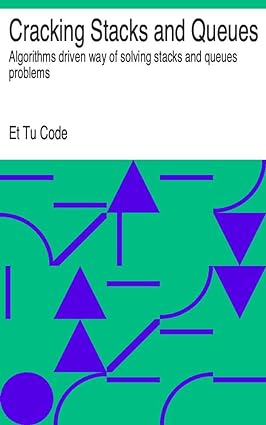
Cracking Stacks and Queues: Algorithms driven way of solving stacks and queues problems
Are you tired of struggling with stacks and queues problems in your computer science or programming courses? Do you want to improve your problem-solving skills and learn new algorithms and data structures? Look no further! This ebook is designed to help you master the art of solving stacks and queues problems using a combination of theoretical knowledge and practical examples.
Chapter 1: Stack Data Structure
Learn how to implement a basic stack data structure, understand its operations, and explore common use cases.
Chapter 2: Balanced Parentheses
Discover the most efficient way to solve balanced parentheses problems using a stack-based approach. Understand the time complexity and practice solving problems.
Chapter 3: Stack Applications in Graphs
Explore how stacks can be used to solve graph traversal problems, including Breadth-First Search (BFS) and Depth-First Search (DFS). Learn how to implement these algorithms using a stack-based approach.
Chapter 4: Stack Sorting Algorithms
Learn about the different stack sorting algorithms, including merge sort, insertion sort, and selection sort. Understand the time complexity and practice solving problems using each algorithm.
Chapter 5: Specialized Stack Problems
Explore specialized stack problems, such as finding the shortest path in a graph using Dijkstra's algorithm, and solving the N-Queens problem using a stack-based approach.
Chapter 6: Dynamic Programming with Stacks
Discover how to use stacks to solve dynamic programming problems, including the Fibonacci sequence and longest common subsequence problems. Understand how to use memoization to improve performance.
Chapter 7: String Reversal Using a Stack
Learn how to reverse a string using a stack-based approach. Understand the time complexity and practice solving problems.
Chapter 8: Problems on Stack Structure
Explore a variety of problems that involve both stacks and queues, including finding the maximum subarray of a given array, and solving the Two Envelope Problem using a stack-based approach.
Chapter 9: Queue Data Structure
Learn how to implement a basic queue data structure, understand its operations, and explore common use cases.
Chapter 10: Queue Applications
Explore how queues can be used to solve various problems, including scheduling jobs on a machine, and solving the famous "Two Envelope Problem" using a queue-based approach.
Chapter 11: Priority Queues
Discover how to use priority queues to solve problems that require prioritizing tasks or items based on their urgency or importance. Learn how to implement and use priority queues in different scenarios.
Chapter 12: Double-Ended Queues (Deque)
Explore the concept of double-ended queues, which are similar to stacks but allow for insertion and deletion from both ends. Understand how to implement and use deques in different scenarios.
Chapter 13: Queue-Based Algorithms
Learn about algorithms that use queues as the primary data structure, including the famous "Floyd's Cycle Detection Algorithm" and the "Knapsack Problem" solution using a queue-based approach.
Chapter 14: Queue Problems
Explore various problems that involve queues, such as finding the shortest path in a graph using Dijkstra's algorithm, and solving the Two Envelope Problem using a queue-based approach.
Your requests in comment!

